Brendan Kearney’s Forest is part of a series that chronicles the adventures of fisher Finn and his dog, Skip. In this installment, the pair travel to a rainforest, where they help a lost baby tapir locate her family. Their search takes them through areas of industrial development, deforestation, and controlled burn, where they meet more displaced animals.
Help children ages 3-9 years explore threats to rainforest ecosystems with one or more of the following activities tied to the book:
Full of Life. When Finn and Skip begin their adventure, they notice lots of animals around them. Return to the first six pages of the book (before the logging camp) and encourage children to notice and name as many different creatures as they can. Then invite them to imagine what various animals are thinking and feeling as they watch Finn and Skip land at the beach, cycle to the river, and paddle deep into the forest. You might point to different animals and ask, What do you think the [animal’s name] is thinking and feeling?
Habitat Must-Haves. Finn and Skip bring food provisions with them on their adventure and create a cozy campsite for eating and sleeping. Lots of animals come stay in the tent because their rainforest habitat is gone. Explore with children what rainforest animals need to survive. With younger children, ask them what kinds of food and places to sleep they think various animals need. With older children, research the specific habitat needs of particular rainforest animals. Ask all ages: When animals can’t find enough food, water, and shelter, what happens to them? What do you think they do when they need a new habitat?
Forest Fires. Sometimes rainforest fires are accidental, caused by lightning or a spark from a campfire or cigarette. Other fires, like the one in the story, are deliberately set by companies who use the wood to make cardboard and paper, and then clear the land for farming. The firefighters suggest several ways to prevent clear-cutting. Discuss their ideas with children. Create a list together of things that you can do to reduce your use of paper, reuse items made from trees, and recycle paper products. Add pictures to your list so all ages can see and remember your ideas.
Compare/Contrast. The rainforest looks very different at different stages of the story. Show the children the pages with the logging trucks, the smokey fog, the big flames, and the protected part of the forest where Finn and Skip find the tapir’s parents. After looking at each page, pause and ask: How do you feel when you look at the rainforest in this picture? What do you wish you could change?
Share with Others. When Skip and Finn got home, they shared what they had learned about the rainforest with others. Invite children to create posters or social media posts to promote the protection of rainforests. Put together a TikTok video, create an Instagram image, design an e-flyer, or work with art supplies on paper or poster board. If you do use paper products, work together on one big poster and then take a photo and share the poster electronically to reduce paper use.

Comments